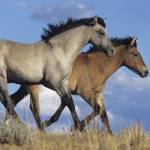What Do Feral Horses Eat?

According to figures released by the U.S. Bureau of Land Management, there are nearly 50,000 horses and burros ranging freely on public lands in the western United States, and almost that many more held in short-term corrals or long-term pastures.
With few natural predators, the herd size is capable of doubling every four years unless control measures are taken. Producers of cattle and sheep who lease grazing rights on federal land claim that feral equines consume enormous quantities of forage, contributing to overgrazing problems and limiting what is available to commercially raised species.
Derek Scasta, a professor at the University of Wyoming, reviewed 40 years of research on the grazing habits of feral equines as well as a number of other domestic and wild species that share the range.
All of the studies determined the diets of various animals through fecal microhistology. With this technique, researchers used microscopes at 100x or 200x magnification to examine feces for fragments from different types of plants. The forage types included graminoids (grasses, sedges, and rushes characterized by narrow leaves); forbs (herbaceous plants with flowers and generally broader leaves); and shrubs (woody plants with multiple stems, such as sagebrush). Scasta compiled information from these studies for a comprehensive document detailing dietary preferences for common range animals.
Figures showed that, on average, horses, cattle, and elk chose grass as the preferred food, consuming this forage for 82, 74, and 47% of their respective diets. Sheep (42%) also ate a moderately large amount of grass, while pronghorn antelope (8%) and deer (6%) consumed relatively little grass. Shrubs made up a large part of the diets of deer (72%) and pronghorn (58%), with cattle and horses eating significant but smaller amounts of this type of forage (14 and 8%, respectively). Forbs were chosen as 38% of the diet for sheep and 34% for pronghorn, but only 10 and 12% for horses and cattle, respectively. Elk and mule deer consumed forbs as almost one-quarter of their diets.
These numbers show that although horses are classified as grazers (eaters of grass), they also eat some brush and tree foliage as do browsers like deer and pronghorn antelope. This may be through necessity (lack of available grasses in a particular area) or by choice. Season and climate also impact dietary composition, with all animals eating what they can find when vegetation is limited by dormancy or drought.








